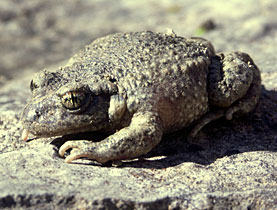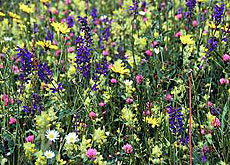Endangered amphibians face fungus threat

A zoologist is trying to find out whether a fungus is behind the decline of the midwife toad – whose numbers have fallen by 50 per cent in Switzerland in recent years.
Her research comes as conservationists sound the alarm over the increased threats to many amphibians around the globe, which led to 2008 being designated the “Year of the Frog”.
Ursina Tobler, from Zurich University’s Zoology department, is researching the effects of the chytrid fungus, which has been implicated in mass die-offs and extinctions in some frog species.
“Chytrid is part of the fungus family which decomposes organic material. This one grows on amphibian skin and decomposes the keratin. It’s a pathogen to amphibians,” Tobler told swissinfo.
The fungus is found in water. In tadpoles it is only found in the mouth parts, but may spread during their metamorphosis into adults.
Although cases were recorded in South Africa in 1928, mass frog mortalities have only been observed in Australia and Central America since the late 1990s. The fungus has also been found in Switzerland.
There are two theories as to its (re)appearance, says Tobler. One is that it spread from South Africa where it is found in clawed frogs, which were used as laboratory animals and pregnancy tests.
“The other is that it’s a normal environmental organism and that some change in the environment has caused it to become a pathogen,” she explained.
Midwife toad
The midwife toad is so-called because the male carries the egg strings around with him until they are ripe to hatch.
Despite its name, however, the species actually belongs to the discoglossidae family of frogs. In Swiss German it is known as the bell frog because of its distinctive call.
“We haven’t seen mass mortalities yet in Switzerland… we know that midwife toads show mass mortalities in Spain, so we are seeing if Swiss midwife toads are dying as well,” said Tobler. It is the first study of its kind in the country.
The zoologist, who is working on her doctorate, is sampling ponds in four regions in Switzerland by swabbing the mouths of tadpoles to detect the disease. Her work also involves raising infected tadpoles to see if they die at metamorphosis.
The three-year research project is being carried out in collaboration with the Institute of Zoology, at the Zoological Society of London.
The midwife toad is one of the most threatened species in Switzerland, explained Benedikt Schmidt, Tobler’s supervisor at Zurich University. The wider picture is also not good.
Under threat
“A third of amphibians is on the global red list of threatened species, which is the highest proportion of all vertebrates,” Schmidt told swissinfo.
“In Switzerland, it’s 70 per cent of the species,” added the zoologist, who helps draw up the lists.
Chytrid could be one reason for amphibians’ disappearance in Switzerland, he said. But they are also threatened by the fact that ponds are becoming fewer and more isolated, meaning the sites cannot be recolonised.
Flood prevention was also a hindrance because flooded areas are wonderful breeding habitants for amphibians since there are no predators.
“Amphibians have survived for millions of years… but if you take away their best habitat and multiple things threaten them – pesticides are a problem, people release fish into ponds where there shouldn’t be any or many amphibians get killed on roads – this is too much of a bad thing,” Schmidt said.
It is not possible to rid a pond of the chytrid fungus once it is there. But people can help by disinfecting their shoes and materials or not transporting animals between ponds.
“If the midwife toads’ decline is due to the fungus, we will radically have to change how we protect amphibians,” warned Schmidt.
Awareness needed
Both zoologists welcome the Year of the Frog as a way of raising awareness of the threats facing frogs and toads.
For Schmidt, sometimes economic factors, such as new shopping malls, override pond conservation in Switzerland.
Building ponds that hold water from April to August only would be one solution, as would making set-aside areas in agriculture – which already exist for butterflies, birds and plants – for frogs.
“Frogs have been protected by law for the past 40 years but they are still in decline, which means enough is not being done,” Schmidt said.
“I would be happy if they would stabilise at a lower level, but we have not even managed to slow down the rate of loss.”
swissinfo, Isobel Leybold-Johnson in Zurich
These western European toads live in forests and often near ponds and streams in open areas. They are about 5 centimes long and plump, with warty, dull-gray skin. They have declined by half in Switzerland since the 1980s.
Midwife toads are nocturnal and terrestrial and give away their presence by their ringing call.
The males carry a string of fertilised eggs on their back. The female expels a strand of eggs, which the male fertilises externally. He then wraps them around his legs to protect them from predators in the water.
When they are ready to hatch, the male wades into shallow water, where he allows the tadpoles to leap out of their eggs.
Conservationists at Amphibian Ark have designated 2008 “Year of the Frog” to raise awareness and funding.
Basel Zoo, Landscape and Animal Park Goldau, Papilorama Foundation in Kerzers, Zurich Zoo, Lausanne Vivarium and Grün Stadt Zurich (environment and parks office), Wildlife Park Langenberg and Sihlwald forest are taking part in Switzerland.
It has been estimated that at least one third of the world’s 6,000 amphibian species – frogs, toads, salamanders, newts and caecilians – are in danger of extinction.
In Switzerland amphibians have been protected since 1967 and are among the most under threat.

In compliance with the JTI standards
More: SWI swissinfo.ch certified by the Journalism Trust Initiative



You can find an overview of ongoing debates with our journalists here. Please join us!
If you want to start a conversation about a topic raised in this article or want to report factual errors, email us at english@swissinfo.ch.